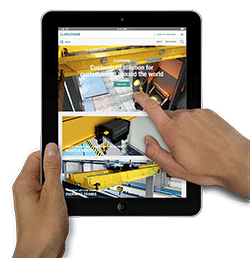A Guide for Bridge and Gantry Crane Drivers (2)
3. Features of Bridge or Gantry Cranes
3.1 The bridge
Each crane has a “bridge” which extends across the crane structure from rail to rail. It sits on an end carriage that has a set of track wheels which run on a rail on either side of the building.
3.2 Working load limit
The working load limit (WLL) can be found printed on the bridge. It is the responsibility of the driver to know the WLL of the crane. In many cranes this will be printed as the safe working load (SWL).
3.3 Long travel
“Long travel” is the direction of travel of the bridge along the rails.
3.4 Cross travel
“Cross travel” is the movement of the “Crab” (see below) from one side of the bridge to the other.
3.5 The crab
The “crab” is the “cross travel unit” from which the hook is lowered and raised. The “crab” houses the hoist motor, the gear box, the rope drum, the brake, the limit switches, the cross travel gear box and motor. It sits on rails attached to the bridge. The power for the “crab” comes from a bus bar or cable on the bridge structure.
3.6 The hook block
The “hook block” us used for raising and lowering the hook. It can be single or multi-roped.
3.7 The sheaves
The rope from the drum runs through the sheaves of the hook block and crab, and over an equalizing sheave (where fitted). The rule of thumb is that the diameter of a sheave must be about 20 times the diameter of the rope.
The depth of an open sheave must be 1.5 times the diameter of the rope.
Where the rope is contained in the sheave the minimum depth of the sheave must equal the diameter of the rope.
The driver must make sure that any sheave showing signs of wear could damage the rope which is replaced and squeaking sheaves are inspected and greased repaired.
3.8 The control cabinet
The control cabinet, which is mounted on the crane, has an all motion isolation switch and contains the contactors.
3.9 The resistor banks
The resistor banks are usually located on the crane bridge or in a well ventilated area. They dissipate heat from the unused electrical current.
Live wires-collector gear-bus bars
There are two types of power supply-AC and DC. Each is usually supplied by collector gear from live wires or insulated bus bars running alongside the crane and runway.
3.10 The main isolating switch
The main isolating switch is usually a lockable switch using either a key or a padlock, for isolating the crane from the power source. It is used for maintenance or in an emergency.
It is usually located near the ladder to the service platform or the crane cabin.
Look for a switch with a bright yellow background with black writing.
3.11 Buffer stops
Buffer stops are fitted to absorb the impact from a collision at either end of long travel.
3.12 Earth wire
The “earth wire” connection takes any electrical leak to earth. It must be visible and near to the permanent wiring connection to the bus bar.
3.13 The cabin
The cabin is attached to the underside of the crane, bridge or crab and contains the controls.
3.14 The pendant control
The hand-held “pendant control” is usually suspended from the bridge on a strainer wire which can be moved from one side of the crane to the other. The controls are normally push button.
Pendant controls usually have:
(1) North – south
(2) East – west
(3) Up- down (hoist movement)
(4) Emergency stop
They may also have a creep speed control.
3.15 The directional compass
Each crane must have a directional compass under the bridge of the crane. The compass helps pendant control drivers with the pendant directional controls. Note: The compass is aligned with the crane travel directions, not magnetic or grid north.










